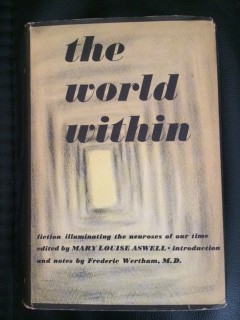 Kavan, Anna. “I Am Lazarus” (1940)
Kavan, Anna. “I Am Lazarus” (1940)
In The World Within: Fiction Illuminating Neuroses of Our Time
Edited by Mary Louise Aswell
Notes and Introduction by Frederic Wertham, M.D.
New York: Whittlesey House, 1947
Related Posts:
The story’s opening paragraph introduces an English doctor who distrusts “anything he did not understand,” particularly “this insulin shock treatment there had been such a fuss about” (p.270).
Polish neurophysiologist and psychiatrist Manfred J. Sakel introduced insulin-shock therapy:
Sakel had used insulin to tranquilize morphine addicts undergoing withdrawal, and in 1927 one addict accidentally received an overdose of insulin and went into a coma. After the patient recovered from the overdose, Sakel noted an improvement in his mental state. Sakel hypothesized that inducing convulsions with insulin could have similar effects in schizophrenics. His initial studies found the treatment effective in 88 percent of his patients, and the method was applied widely for a brief period. Follow-up studies showed the long-term results to be less satisfactory, and insulin-shock treatment was replaced by other methods of treatment. [1]
Until the discovery of the tranquilizing drugs, variations of insulin-shock therapy (also called insulin-coma therapy) were commonly used in the treatment of schizophrenia and other psychotic conditions. With insulin-shock treatment, the patient is given increasingly large doses of insulin, which reduce the sugar content of the blood and bring on a state of coma. Usually the comatose condition is allowed to persist for about an hour, at which time it is terminated by administering warm salt solution via stomach tube or by intravenous injection of glucose. Insulin shock had its greatest effectiveness with schizophrenic patients whose illness had lasted less than two years. [2]
Two large studies carried out in the USA in 1939 and 1942 gave him fame and helped his technique to rapidly spread out around the world… . [However], Initial enthusiasm was followed by a decrease in the use of insulin coma therapy, after further controlled studies showed that real cure was not achieved and that improvements were many times temporary. [3]
The opening four paragraphs of Anna Kavan’s story introduce us to the unnamed English doctor who lives in a village near the wealthy Mrs. Bow. When the doctor plans a motor trip to Europe, Mrs. Bow asks him to stop in and see her son at the clinic where he’s being treated for dementia praecox, an outmoded term for what we now call schizophrenia. Readers are guided not to think highly of this doctor: “The English doctor was not a very good doctor. He was middle-aged and frustrated and undistinguished” (p. 270). When Mrs. Bow had told him of her plan a year earlier to send her son to the clinic for treatment, the doctor had opposed the idea. “It was a useless expense. It couldn’t possibly do any good” (p. 271).
Not wishing to offend the rich Mrs. Bow, the doctor stops by the European clinic:
He glanced at the beautifully kept gardens. The grounds were really magnificent, the watered lawns green in spite of the dry summer, every tree pruned to perfection, the borders brilliant with flowers. (p. 271)
The clinic superintendent, who “had exactly estimated the unimportance of his companion” (p. 272), describes Mr. Bow’s prognosis:
“We’re very proud of Mr. Bow,” he said. “He’s an outstanding example of the success of the treatment. He responded wonderfully well from the start and I consider him a quite remarkable cure. In a few months he should be well enough to go home.” (p. 272)
Apparently the mediocre doctor from England who had dismissed the possibility of a cure was wrong about the treatment given at this clinic with the perfectly manicured grounds.
The superintendent takes the doctor into a workroom where some patients, including Mr. Bow, are working with leather: “The different pairs of hands, large and small, rose and fell over the table… . The Englishman looked uneasily at the faces and at the hands which seemed to be rising and falling of their own volition in the banded sunshine above the table” (pp. 272–273). Mr. Bow, with his “flat, hazel eyes,” “sat stiffly correct in his place at the sunny table” (p. 273). This opening section of the story ends with the doctor’s reflection on what he has seen:
“I should never have believed it possible,” the Englishman said with emphasis and repressed indignation. “Never.”
He felt disapproving and indignant and uncomfortable without quite knowing why. Of course, the boy looks normal enough, he said to himself. He seems quiet and self-controlled. But there must be a catch in it somewhere. You can’t go against nature like that. It just isn’t possible. He thought uneasily of the young inexpressive face and the curious flat look of the eyes. (p. 274)
Then the focus of the story abruptly switches to Mr. Bow:
He spoke to no one and nobody spoke to him. He methodically went on sewing the pigskin belt with steady, regular movements of his soft hands… All around the table were different colored shapes whose mouths opened and closed and emitted sounds that meant nothing to him. He did not mind either the shapes or the sounds. They were part of the familiar atmosphere of the workroom, where he felt comfortable and at ease. (p. 274)
And suddenly the reader begins to see what the English doctor vaguely sensed but was unable to understand: that the outside viewer’s perception of Mr. Bow’s existence is vastly different from Mr. Bow’s own. On his way to lunch Mr. Bow walks “rather stiffly” through grasses that respond felinely to his touch: “like thin sensitive cats they arched themselves to receive the caress of his fingertips” (p. 275). Daisies growing in the field “had yellow eyes that squinted craftily through the grass” (p. 275). In the washroom
Several coats hung on the wall. Thomas Bow avoided the washbasins nearest the coats. The hanging shapes filled him with deep suspicion. He watched them out of the ends of his eyes to make sure they did not get up to anything while he was washing his hands. (pp. 276–277)
And when Mr. Bow enters the dining room
The young man looked round cautiously. The pretty dresses of the women gave him pleasure but he was not at ease. At any moment something might pounce on him, something for which he did not have the formula. He waited tensely, on enemy ground… . The waiters, like well-trained sheep dogs, skillfully maneuvered the patients toward their chairs. (p. 278)
Now we realize that the perfectly ordered and manicured grounds of the fancy clinic represent the perfectly ordered and regimented existence of the patients, who have been trained to respond like robots. The irony of the situation is that the undistinguished, “not very good” English doctor was correct in his evaluation of how well Mr. Bow’s treatment has worked.
The story’s title provides a final stroke of irony:
“He doesn’t know how lucky he is,” said the dark doctor. “We’ve pulled him back literally from a living death. That’s the sort of thing that encourages one in this work.”
Mr. Bow walked carefully in the sunshine. He did not know how lucky he was and perhaps that was rather lucky as well. (p. 281)
References
[1] “Manfred J. Sakel”. Encyclopædia Britannica. Encyclopædia Britannica Online.
Encyclopædia Britannica Inc., 2014. Web. 02 Nov. 2014
http://www.britannica.com/EBchecked/topic/518669/Manfred-J-Sakel.
[2] “Shock therapy”. Encyclopædia Britannica. Encyclopædia Britannica Online.
Encyclopædia Britannica Inc., 2014. Web. 02 Nov. 2014
http://www.britannica.com/EBchecked/topic/541334/shock-therapy#ref145472
[3] Renato M.E. Sabbatini. The History of Shock Therapy in Psychiatry .

